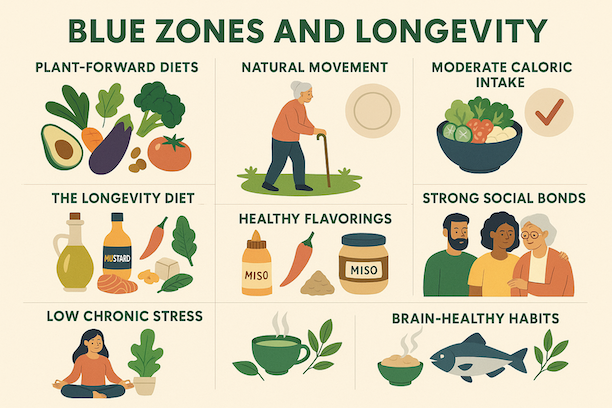| « Why the Bio-Surveillance State Needs Feminism to Survive | U.S. Government Black Ops and Blind Eyes: A Republic of Shadows » |
Blue Zones and Longevity – Lessons from the World’s Healthiest Centenarians
Tracy Turner

Discover the 5 proven longevity secrets from the world's healthiest elders - from immune-boosting diets to stress-reducing rituals that add years to your life. Dedicated to the late Angel Kazuko Nishinaka of Los Angeles.
Caveat: This article explores lifestyle patterns in Blue Zones but is not medical advice. Always consult a healthcare provider before making significant changes to your health regimen.
I. Introduction
What if the key to a long, vibrant life was neither locked in genetics nor hidden in pharmaceutical patents, but already on your plate, in your community, and embedded in how you move through the day?
The term “Blue Zones” refers to five geographically distinct regions with an exceptional prevalence of centenarians—individuals who live to or beyond the age of 100. These populations not only live longer than average, but also experience what might be termed “compressed morbidity”—remaining mentally and physically active until the very final chapter of life.
Documented by National Geographic explorer Dan Buettner, and popularized through the Netflix documentary "Live to 100: Secrets of the Blue Zones", these longevity enclaves include:
- Okinawa, Japan
- Sardinia, Italy
- Nicoya, Costa Rica
- Icaria, Greece
- Loma Linda, California (notably a community of Seventh-day Adventists)
These cultures provide a living laboratory for studying healthy aging, cognitive vitality, immune resilience, and resistance to chronic disease.
II. The Five Blue Zones – What They Have in Common
Despite their cultural and geographic diversity, Blue Zones share several overlapping lifestyle patterns—each of which plays a synergistic role in promoting healthspan (not merely lifespan):
- Plant-Forward Diets: Meals center around legumes, leafy greens, whole grains, tubers, and seasonal vegetables, with meat consumed sparingly, if at all. When meat is eaten, it is often seafood—not mammals. This is crucial: seafood—especially cold-water fatty fish like sardines, mackerel, anchovies, and wild salmon—are rich in Omega-3 fatty acids (EPA and DHA), which reduce systemic inflammation, balance immune responses, and support both cardiovascular and neurological resilience. Red meat, conversely, promotes pro-inflammatory pathways, elevates IGF-1, and contributes to gut dysbiosis when consumed in excess.
- Natural Movement: Daily activity is built into routine—walking, squatting, gardening, carrying, climbing. Not a single treadmill in sight.
- Strong Social Bonds: From Okinawa’s moai (social circles) to Sardinian multigenerational households, these tight-knit ties directly bolster mental health and immune function by reducing chronic stress.
- Low Chronic Stress: Practiced rituals—whether Sabbath observance, daily prayer, tea ceremonies, or afternoon naps—lower cortisol and modulate inflammatory cytokines.
- Moderate Caloric Intake: Okinawa’s Hara Hachi Bu principle—eating until 80% full—lowers oxidative load and supports autophagy, enhancing cellular renewal.
III. The Longevity Diet Breakdown: Mediterranean & Okinawan
The Mediterranean Diet (Sardinia & Icaria)
Renowned for cardiovascular and immunological benefits, this diet emphasizes:
- Core Foods: Extra virgin olive oil, chickpeas, lentils, wild herbs, greens, garlic, walnuts, and small oily fish like sardines.
- Scientific Evidence: The PREDIMED study (NEJM, 2013) demonstrated a 30% reduction in major cardiac events. Long-term adherence also correlates with reduced inflammatory markers like IL-6 and CRP.
Key immunomodulators include:
- Garlic: Allicin enhances natural killer cell activity.
- Olive oil polyphenols: Oleuropein and hydroxytyrosol reduce inflammatory prostaglandins.
- Wild herbs (oregano, thyme, sage): Contain rosmarinic acid, a potent regulator of T-cell activity.
- Sardines: Deliver Omega-3s and Vitamin D—both critical for immune modulation.
The Okinawan Diet
Rooted in simplicity and anti-inflammatory design, it features:
- Core Foods: Purple sweet potatoes, tofu, turmeric, miso, bitter melon, and seaweed.
- Scientific Note: Okinawan elders exhibit superior mitochondrial efficiency and immunosenescence delay—partly due to their consumption of low-glycemic, micronutrient-rich foods.
Okinawan immunomodulators include:
- Turmeric (Curcumin): Inhibits NF-κB, a central inflammatory switch.
- Seaweed: Provides iodine and fucoidans with antiviral and anticancer potential.
- Miso: A fermented soy product rich in probiotics and peptides that modulate gut-associated lymphoid tissue (GALT).
IV. Flavor Without Fat – The Forgotten Secret of Longevity Cooking
One overlooked hallmark of Blue Zone culinary tradition is the use of flavorings that heal, not harm. While many Western and Latin cuisines lean on heavy fats—cheeses, lard, sour cream, butter, and fatty meats—to deliver richness, Blue Zones take a radically different approach. They cultivate taste using anti-inflammatory, immunoactive seasonings and condiments that stimulate the palate without burdening the gut or liver.
- Mediterranean cultures build flavor with garlic, onion, lemon, oregano, rosemary, and thyme. Olive oil is used not as a frying base, but as a raw drizzle—preserving its polyphenolic integrity.
- Japanese and Okinawan cuisines deploy miso, wasabi, pickled daikon, umeboshi, soy sauce, and seaweed for umami. These not only flavor food but enhance gut flora and modulate mucosal immunity.
- Chilies in moderate amounts act as immunostimulants, increasing circulation and boosting innate immune response. Capsaicin also downregulates inflammatory mediators like TNF-α.
- Mustard and horseradish, common in both Eastern and European traditions, activate detoxification enzymes via glucosinolates and support lymphatic flow.
- Fermented condiments like kimchi, tamari, or natto not only deliver tang and depth, they seed the gut with beneficial bacteria that speak directly to immune cells.
The result? Robust flavor, minimal inflammation, and no post-meal crash.
V. Brain Health: The Critical Factor in Longevity
Living to 99 with 29 years of dementia is not longevity—it is torment prolonged. The most important organ for aging well is the brain, which orchestrates everything from mobility to digestion to immune signaling.
Protective Brain Habits in Blue Zones
- Social Connectivity: Community engagement reduces dementia risk by up to 40% (Harvard Study of Adult Development).
- Nutritional Neuroprotection:
- Omega-3s: From sardines, walnuts, and flaxseed, they regulate microglial activity.
- Probiotic-Rich Yogurt: Supports the gut-brain axis via the vagus nerve. Brands supported by research include:
- Siggi’s (notably high in Bifidobacterium lactis)
- Nancy’s Organic Yogurt (13 live cultures including L. acidophilus)
- Maple Hill Creamery (100% grass-fed)
- FAGE Total and Brown Cow Cream Top
- Polyphenol-Rich Oils and Seeds:
- Extra Virgin Olive Oil: Reduces beta-amyloid aggregation.
- Black Seed Oil: Thymoquinone modulates neuroinflammation.
- Pumpkin and Flaxseeds: Provide lignans, zinc, magnesium, and ALA (a plant Omega-3).
- Herbal Teas with Immuno-Neuroprotective Effects:
- Tulsi (Holy Basil): Cortisol modulation and T-regulatory cell support.
- Green Tea (Matcha): EGCG improves T-cell homeostasis and neuronal plasticity.
- Bacopa Monnieri: Cognitive enhancer with adaptogenic immune benefits.
VI. Traditional Medicine: Between Wisdom and Wishful Thinking
Ancient healing systems offer frameworks that—when examined through immunological science—reveal potent tools.
Top Immunomodulatory Botanicals (Backed by Evidence)
- Reishi Mushroom (Ganoderma lucidum): Enhances dendritic cell activity and balances Th1/Th2 response.
- Ashwagandha (Withania somnifera): Reduces stress-induced immune suppression.
- Astragalus membranaceus: Increases white blood cell count and interferon production.
- Nigella sativa (Black Seed): Thymoquinone modulates innate immunity and reduces autoimmune flare-ups.
- Fermented Herbal Tonics (like Korean Ginseng teas and Kampo formulas): Encourage microbiota diversity and mucosal immunity.
Kampo and Ayurveda may offer immunological blueprints when cross-referenced with contemporary findings. Kampo herbs like Shiso (perilla) have been shown to regulate allergic response and mast cell stabilization.
VII. Repurposed Drugs & Longevity Hype – A Quick Reality Check
Metformin
An antidiabetic drug gaining attention for potential longevity effects.
- Lowers systemic inflammation and mTOR activity, key to immune aging.
- Diabetics on metformin live longer than those not on it (Bannister et al., 2014).
- May reduce cancer and dementia risk—but use in healthy populations is still debated.
Metformin (re-purposed by some M.D.s)
Cardiovascular Benefits
Boosts endothelial function (↑ nitric oxide)
Lowers LDL, triglycerides, blood pressure
Reduces inflammation & oxidative stress (↓ CRP, IL-6)
Prevents clots & artery stiffening
Anti-Cancer Effects
Blocks mTOR/AMPK, starving tumors
Lowers insulin/IGF-1 (fuels cancer)
Induces apoptosis, inhibits metastasis
Reduces chronic inflammation (cancer driver)
Longevity Mechanisms
Activates AMPK (mimics calorie restriction)
Enhances mitochondrial function & autophagy
Reduces senescence & glycation damage
Modulates gut microbiome & immunity
Evidence
CV: -39% heart attacks, -30-50% strokes
Cancer: -30-50% (breast/colorectal)
Natural Immunomodulatory Alternatives
- Walnuts: High in Omega-3s and polyphenols that regulate cytokines.
- Broccoli Sprouts: Rich in sulforaphane—boosts glutathione and activates anti-inflammatory gene expression.
- Olive Oil: Supports macrophage flexibility and balances lipid-derived immune signals.
- Fermented Foods: Kimchi, kefir, sauerkraut—probiotic diversity leads to immunological versatility.
- Pumpkin and Sesame Seeds: Deliver trace minerals essential to antibody production.
VIII. How to Apply Blue Zone Principles Today
- Adopt a 90% Plant-Based Diet
- Emphasize legumes, greens, and fermented vegetables. When you eat meat, choose seafood—especially sardines, mackerel, and salmon—for their immunological and cardiovascular benefits.
- Move Daily in Natural Ways
- Walk, squat, carry, garden. Let your body be your gym.
- Build Community
- Immunity begins with unity. Relationships buffer against chronic inflammation.
- Destress with Intention
- Try deep breathing, herbal teas, music, or prayer. Your immune system listens.
- Integrate Neuro-Immune Teas and Herbs
- Tulsi, Reishi, Astragalus, Bacopa, Matcha, and fermented ginger-root infusions.
- Feed Your Gut-Brain-Immune Axis
- Choose yogurts with active Bifidobacterium and Lactobacillus. Support with fiber and prebiotics.
- Use Polyphenol and Omega-3 Powerhouses
- EVOO, black seed oil, walnuts, flaxseed, pumpkin seeds, and sardines form the oil lamp of immunity.
- Flavor Intelligently
- Spice and ferment your food for both taste and immune advantage. Avoid dependence on fatty flavoring agents. Think turmeric, chili, miso, lemon, herbs, and wasabi—not butter, cheese, or bacon grease.
- Honor Circadian Rhythms
- Melatonin is not just for sleep—it is an immune sentinel.
IX. Staying Longer
True longevity is the art of remaining lucid, connected, and disease-resilient into your final decades. The Blue Zones offer us not a diet, but a life design—rooted in plants, purpose, people, and peace.
Call to Action: Watch "Live to 100: Secrets of the Blue Zones" and re-examine your plate, your routine, and your rhythms.
“Optimize the brain, fortify the gut, and align the immune clock. That is how we age with clarity and grace.”
Blue Zones and Longevity – Lessons from the World’s Healthiest Centenarians
© 2025 Tracy Turner
References
- Buettner, D. (2008). The Blue Zones: Lessons for living longer from the people who've lived the longest. National Geographic Books.
- Buettner, D., & Skemp, S. (2016). Blue Zones: Lessons from the world's longest lived. American Journal of Lifestyle Medicine, 10(5), 318-321. https://doi.org/10.1177/1559827616637066
- Estruch, R., et al. (2013). Primary prevention of cardiovascular disease with a Mediterranean diet. New England Journal of Medicine, 368(14), 1279-1290. https://doi.org/10.1056/NEJMoa1200303
- Willcox, D. C., Willcox, B. J., Todoriki, H., & Suzuki, M. (2009). The Okinawan diet: Health implications of a low-calorie, nutrient-dense, antioxidant-rich dietary pattern low in glycemic load. Journal of the American College of Nutrition, 28(sup4), 500S-516S. https://doi.org/10.1080/07315724.2009.10718117
- Poulain, M., Pes, G. M., Grasland, C., Carru, C., Ferucci, L., Baggio, G., ... & Deiana, L. (2004). Identification of a geographic area characterized by extreme longevity in the Sardinia island: The AKEA study. Experimental Gerontology, 39(9), 1423-1429. https://doi.org/10.1016/j.exger.2004.06.016
- Bannister, C. A., et al. (2014). Can people with type 2 diabetes live longer than those without? A comparison of mortality in people initiated with metformin or sulphonylurea monotherapy and matched, non-diabetic controls. Diabetes, Obesity and Metabolism, 16(11), 1165-1173. https://doi.org/10.1111/dom.12354
- Waldinger, R. J., & Schulz, M. S. (2010). What's love got to do with it? Social functioning, perceived health, and daily happiness in married octogenarians. Psychology and Aging, 25(2), 422. https://doi.org/10.1037/a0019087
- Willcox, B. J., Willcox, D. C., & Suzuki, M. (2014). The Okinawa Program: How the world's longest-lived people achieve everlasting health—and how you can too. Harmony.
Additional Resources
- Blue Zones Official Website: https://www.bluezones.com
- Netflix (2023). Live to 100: Secrets of the Blue Zones. [Documentary series]. https://www.netflix.com/title/81214929



